Deepu John
TinyDrop: Tiny Model Guided Token Dropping for Vision Transformers
Sep 03, 2025Abstract:Vision Transformers (ViTs) achieve strong performance in image classification but incur high computational costs from processing all image tokens. To reduce inference costs in large ViTs without compromising accuracy, we propose TinyDrop, a training-free token dropping framework guided by a lightweight vision model. The guidance model estimates the importance of tokens while performing inference, thereby selectively discarding low-importance tokens if large vit models need to perform attention calculations. The framework operates plug-and-play, requires no architectural modifications, and is compatible with diverse ViT architectures. Evaluations on standard image classification benchmarks demonstrate that our framework reduces FLOPs by up to 80% for ViTs with minimal accuracy degradation, highlighting its generalization capability and practical utility for efficient ViT-based classification.
Optimal Brain Connection: Towards Efficient Structural Pruning
Aug 07, 2025Abstract:Structural pruning has been widely studied for its effectiveness in compressing neural networks. However, existing methods often neglect the interconnections among parameters. To address this limitation, this paper proposes a structural pruning framework termed Optimal Brain Connection. First, we introduce the Jacobian Criterion, a first-order metric for evaluating the saliency of structural parameters. Unlike existing first-order methods that assess parameters in isolation, our criterion explicitly captures both intra-component interactions and inter-layer dependencies. Second, we propose the Equivalent Pruning mechanism, which utilizes autoencoders to retain the contributions of all original connection--including pruned ones--during fine-tuning. Experimental results demonstrate that the Jacobian Criterion outperforms several popular metrics in preserving model performance, while the Equivalent Pruning mechanism effectively mitigates performance degradation after fine-tuning. Code: https://github.com/ShaowuChen/Optimal_Brain_Connection
ORXE: Orchestrating Experts for Dynamically Configurable Efficiency
May 07, 2025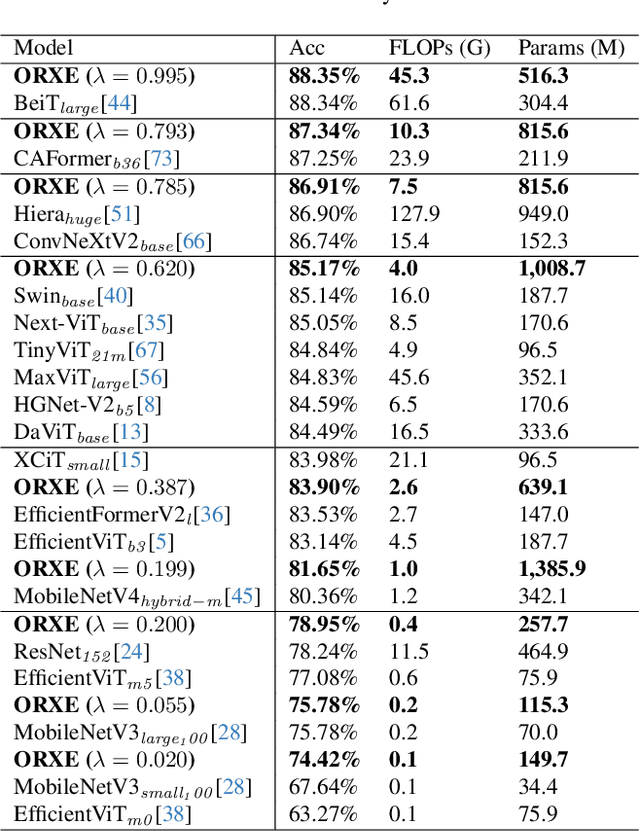
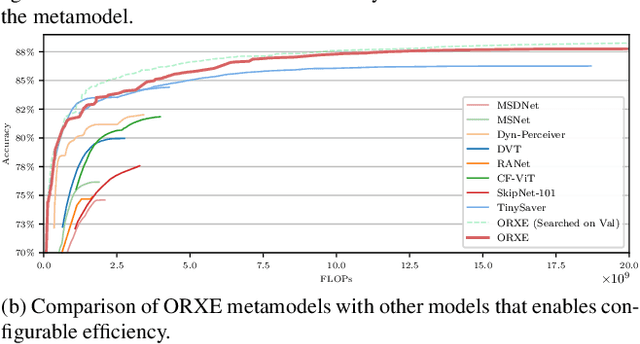
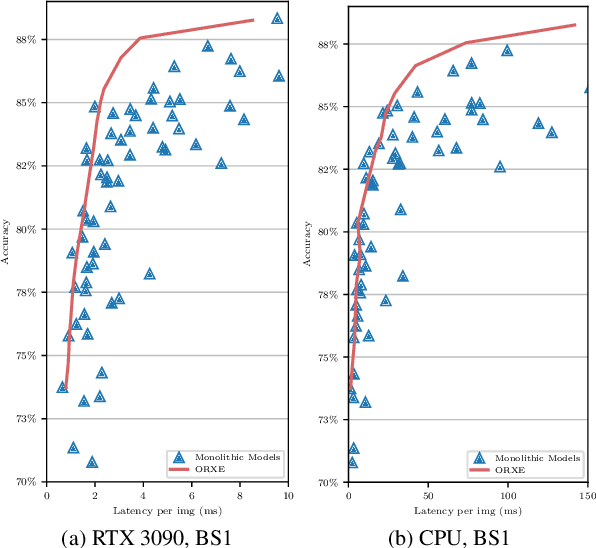
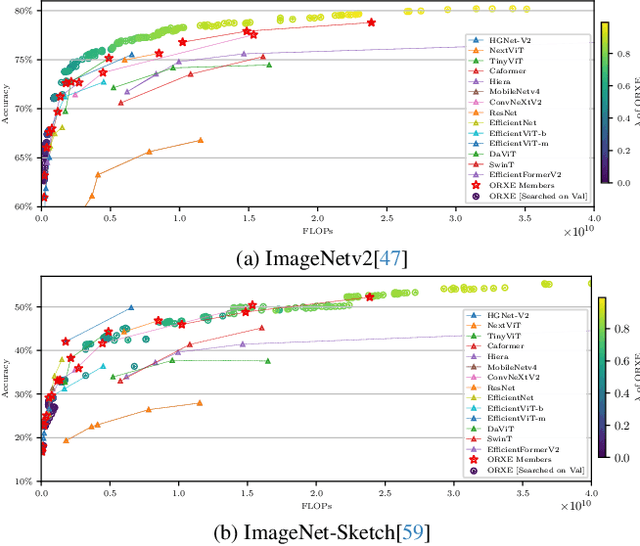
Abstract:This paper presents ORXE, a modular and adaptable framework for achieving real-time configurable efficiency in AI models. By leveraging a collection of pre-trained experts with diverse computational costs and performance levels, ORXE dynamically adjusts inference pathways based on the complexity of input samples. Unlike conventional approaches that require complex metamodel training, ORXE achieves high efficiency and flexibility without complicating the development process. The proposed system utilizes a confidence-based gating mechanism to allocate appropriate computational resources for each input. ORXE also supports adjustments to the preference between inference cost and prediction performance across a wide range during runtime. We implemented a training-free ORXE system for image classification tasks, evaluating its efficiency and accuracy across various devices. The results demonstrate that ORXE achieves superior performance compared to individual experts and other dynamic models in most cases. This approach can be extended to other applications, providing a scalable solution for diverse real-world deployment scenarios.
A Review on Multisensor Data Fusion for Wearable Health Monitoring
Dec 08, 2024



Abstract:The growing demand for accurate, continuous, and non-invasive health monitoring has propelled multi-sensor data fusion to the forefront of healthcare technology. This review aims to provide an overview of the development of fusion frameworks in the literature and common terminology used in fusion literature. The review introduces the fusion classification standards and methods that are most relevant from an algorithm development perspective. Applications of the reviewed fusion frameworks in fields such as defense, autonomous driving, robotics, and image fusion are also discussed to provide contextual information on the various fusion methodologies that have been developed in this field. This review provides a comprehensive analysis of multi-sensor data fusion methods applied to health monitoring systems, focusing on key algorithms, applications, challenges, and future directions. We examine commonly used fusion techniques, including Kalman filters, Bayesian networks, and machine learning models. By integrating data from various sources, these fusion approaches enhance the reliability, accuracy, and resilience of health monitoring systems. However, challenges such as data quality and differences in acquisition systems exist, calling for intelligent fusion algorithms in recent years. The review finally converges on applications of fusion algorithms in biomedical inference tasks like heartbeat detection, respiration rate estimation, sleep apnea detection, arrhythmia detection, and atrial fibrillation detection.
ECG Biometric Authentication Using Self-Supervised Learning for IoT Edge Sensors
Sep 09, 2024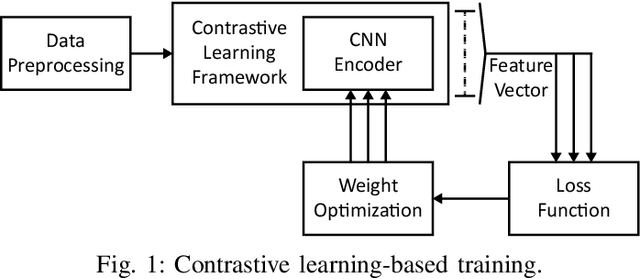
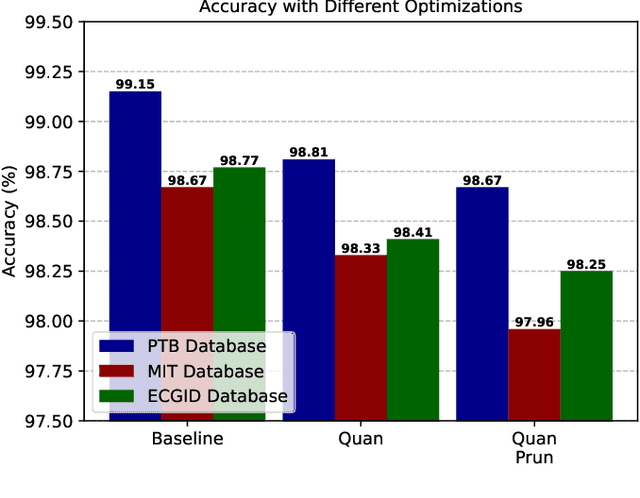

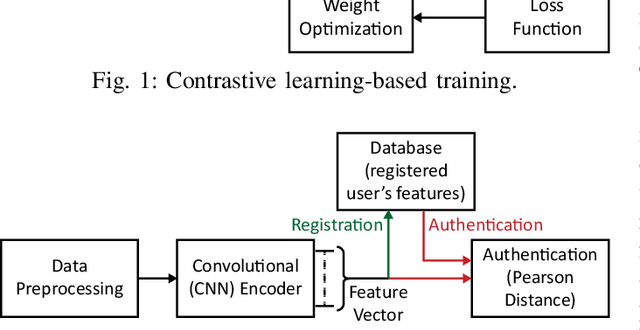
Abstract:Wearable Internet of Things (IoT) devices are gaining ground for continuous physiological data acquisition and health monitoring. These physiological signals can be used for security applications to achieve continuous authentication and user convenience due to passive data acquisition. This paper investigates an electrocardiogram (ECG) based biometric user authentication system using features derived from the Convolutional Neural Network (CNN) and self-supervised contrastive learning. Contrastive learning enables us to use large unlabeled datasets to train the model and establish its generalizability. We propose approaches enabling the CNN encoder to extract appropriate features that distinguish the user from other subjects. When evaluated using the PTB ECG database with 290 subjects, the proposed technique achieved an authentication accuracy of 99.15%. To test its generalizability, we applied the model to two new datasets, the MIT-BIH Arrhythmia Database and the ECG-ID Database, achieving over 98.5% accuracy without any modifications. Furthermore, we show that repeating the authentication step three times can increase accuracy to nearly 100% for both PTBDB and ECGIDDB. This paper also presents model optimizations for embedded device deployment, which makes the system more relevant to real-world scenarios. To deploy our model in IoT edge sensors, we optimized the model complexity by applying quantization and pruning. The optimized model achieves 98.67% accuracy on PTBDB, with 0.48% accuracy loss and 62.6% CPU cycles compared to the unoptimized model. An accuracy-vs-time-complexity tradeoff analysis is performed, and results are presented for different optimization levels.
HiRED: Attention-Guided Token Dropping for Efficient Inference of High-Resolution Vision-Language Models in Resource-Constrained Environments
Aug 20, 2024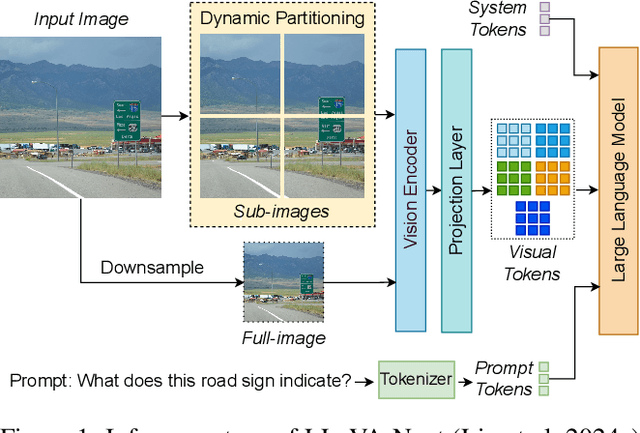

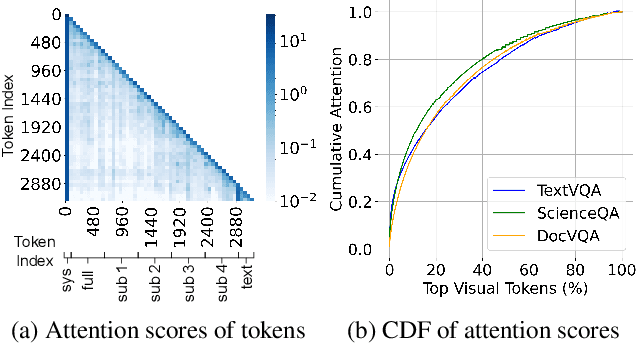

Abstract:High-resolution Vision-Language Models (VLMs) have been widely used in multimodal tasks to enhance accuracy by preserving detailed image information. However, these models often generate excessive visual tokens due to encoding multiple partitions of the input image. Processing these excessive visual tokens is computationally challenging, especially in resource-constrained environments with commodity GPUs. To support high-resolution images while meeting resource constraints, we propose High-Resolution Early Dropping (HiRED), a token-dropping scheme that operates within a fixed token budget before the Large Language Model (LLM) stage. HiRED can be integrated with existing high-resolution VLMs in a plug-and-play manner, as it requires no additional training while still maintaining superior accuracy. We strategically use the vision encoder's attention in the initial layers to assess the visual content of each image partition and allocate the token budget accordingly. Then, using the attention in the final layer, we select the most important visual tokens from each partition within the allocated budget, dropping the rest. Empirically, when applied to LLaVA-Next-7B on NVIDIA TESLA P40 GPU, HiRED with a 20% token budget increases token generation throughput by 4.7, reduces first-token generation latency by 15 seconds, and saves 2.3 GB of GPU memory for a single inference.
KWT-Tiny: RISC-V Accelerated, Embedded Keyword Spotting Transformer
Jul 22, 2024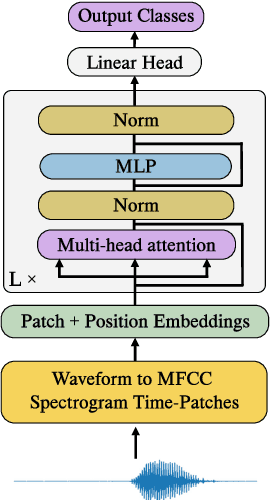
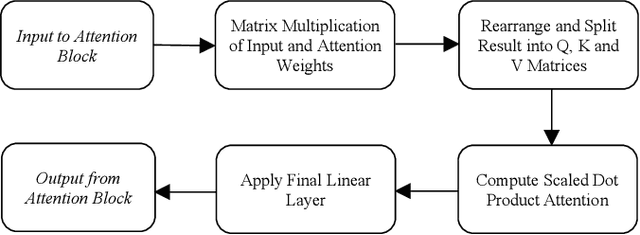
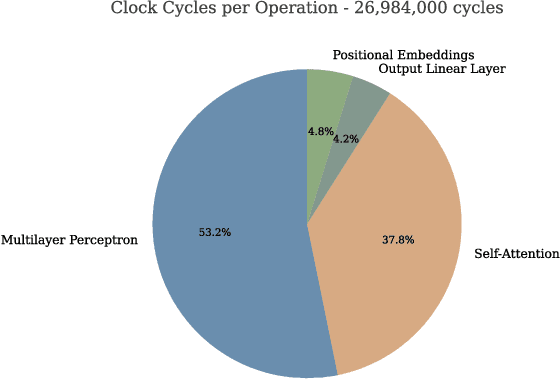
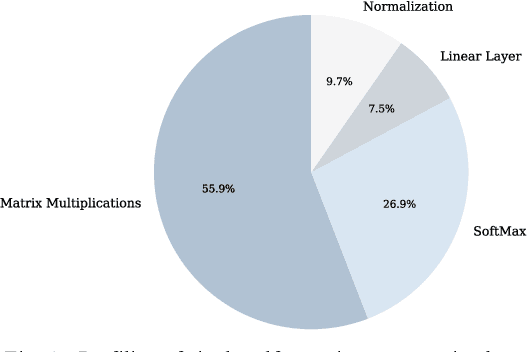
Abstract:This paper explores the adaptation of Transformerbased models for edge devices through the quantisation and hardware acceleration of the ARM Keyword Transformer (KWT) model on a RISC-V platform. The model was targeted to run on 64kB RAM in bare-metal C using a custom-developed edge AI library. KWT-1 was retrained to be 369 times smaller, with only a 10% loss in accuracy through reducing output classes from 35 to 2. The retraining and quantisation reduced model size from 2.42 MB to 1.65 kB. The integration of custom RISC-V instructions that accelerated GELU and SoftMax operations enabled a 5x speedup and thus ~5x power reduction in inference, with inference clock cycle counts decreasing from 26 million to 5.5 million clock cycles while incurring a small area overhead of approximately 29%. The results demonstrate a viable method for porting and accelerating Transformer-based models in low-power IoT devices.
Tiny Models are the Computational Saver for Large Models
Mar 26, 2024Abstract:This paper introduces TinySaver, an early-exit-like dynamic model compression approach which employs tiny models to substitute large models adaptively. Distinct from traditional compression techniques, dynamic methods like TinySaver can leverage the difficulty differences to allow certain inputs to complete their inference processes early, thereby conserving computational resources. Most existing early exit designs are implemented by attaching additional network branches to the model's backbone. Our study, however, reveals that completely independent tiny models can replace a substantial portion of the larger models' job with minimal impact on performance. Employing them as the first exit can remarkably enhance computational efficiency. By searching and employing the most appropriate tiny model as the computational saver for a given large model, the proposed approaches work as a novel and generic method to model compression. This finding will help the research community in exploring new compression methods to address the escalating computational demands posed by rapidly evolving AI models. Our evaluation of this approach in ImageNet-1k classification demonstrates its potential to reduce the number of compute operations by up to 90%, with only negligible losses in performance, across various modern vision models. The code of this work will be available.
DyCE: Dynamic Configurable Exiting for Deep Learning Compression and Scaling
Mar 04, 2024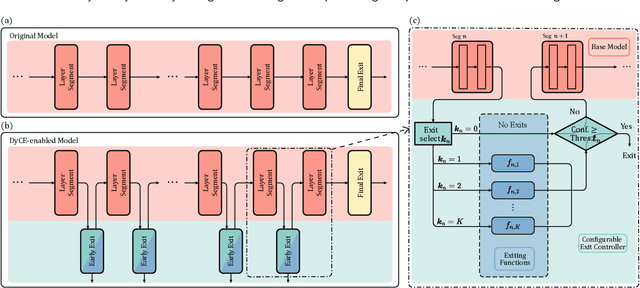
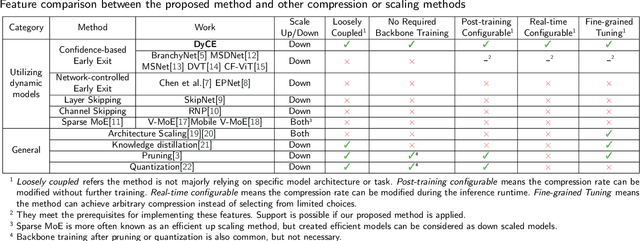
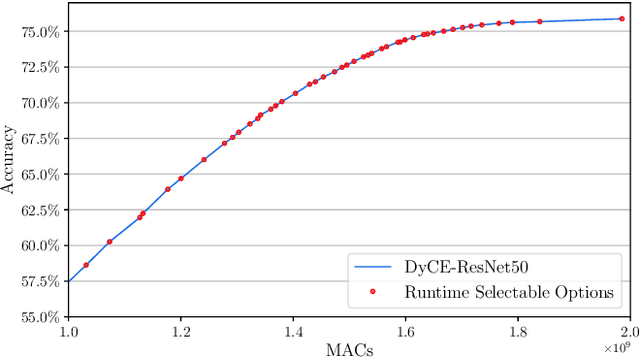
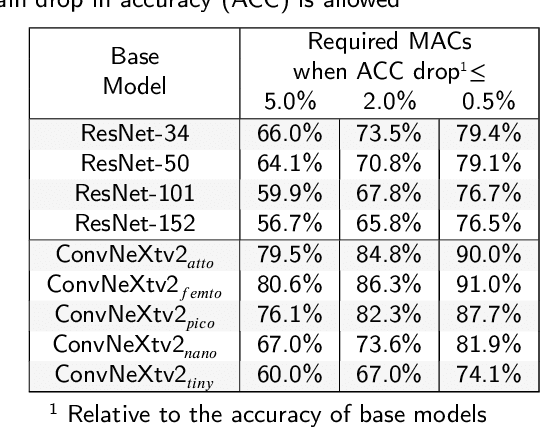
Abstract:Modern deep learning (DL) models necessitate the employment of scaling and compression techniques for effective deployment in resource-constrained environments. Most existing techniques, such as pruning and quantization are generally static. On the other hand, dynamic compression methods, such as early exits, reduce complexity by recognizing the difficulty of input samples and allocating computation as needed. Dynamic methods, despite their superior flexibility and potential for co-existing with static methods, pose significant challenges in terms of implementation due to any changes in dynamic parts will influence subsequent processes. Moreover, most current dynamic compression designs are monolithic and tightly integrated with base models, thereby complicating the adaptation to novel base models. This paper introduces DyCE, an dynamic configurable early-exit framework that decouples design considerations from each other and from the base model. Utilizing this framework, various types and positions of exits can be organized according to predefined configurations, which can be dynamically switched in real-time to accommodate evolving performance-complexity requirements. We also propose techniques for generating optimized configurations based on any desired trade-off between performance and computational complexity. This empowers future researchers to focus on the improvement of individual exits without latent compromise of overall system performance. The efficacy of this approach is demonstrated through image classification tasks with deep CNNs. DyCE significantly reduces the computational complexity by 23.5% of ResNet152 and 25.9% of ConvNextv2-tiny on ImageNet, with accuracy reductions of less than 0.5%. Furthermore, DyCE offers advantages over existing dynamic methods in terms of real-time configuration and fine-grained performance tuning.
Unsupervised Pre-Training Using Masked Autoencoders for ECG Analysis
Oct 17, 2023



Abstract:Unsupervised learning methods have become increasingly important in deep learning due to their demonstrated large utilization of datasets and higher accuracy in computer vision and natural language processing tasks. There is a growing trend to extend unsupervised learning methods to other domains, which helps to utilize a large amount of unlabelled data. This paper proposes an unsupervised pre-training technique based on masked autoencoder (MAE) for electrocardiogram (ECG) signals. In addition, we propose a task-specific fine-tuning to form a complete framework for ECG analysis. The framework is high-level, universal, and not individually adapted to specific model architectures or tasks. Experiments are conducted using various model architectures and large-scale datasets, resulting in an accuracy of 94.39% on the MITDB dataset for ECG arrhythmia classification task. The result shows a better performance for the classification of previously unseen data for the proposed approach compared to fully supervised methods.
 Add to Chrome
Add to Chrome Add to Firefox
Add to Firefox Add to Edge
Add to Edge